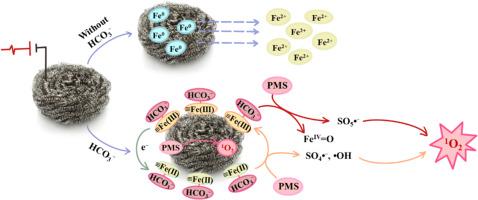Bicarbonate ions enhanced surface Fe(II) regeneration and peroxymonosulfate activation on stainless-steel scrubber cathode for BPA degradation
IF 6.7
2区 工程技术
Q1 ENGINEERING, CHEMICAL
引用次数: 0
Abstract
Bicarbonate ions (HCO3−), commonly present in natural water sources, exert complex influences on peroxymonosulfate (PMS)-based advanced oxidation processes (AOPs). This study investigates the role of HCO3− in a novel electrochemical system using a stainless-steel scrubber cathode (SSSC) for PMS activation. The buffering effect of HCO3− shifts the dominant Fe(II) species from dissolved Fe2+ ions to surface-bound Fe(II) (≡Fe(II)) within the HCO3−/PMS/SSSC system. Furthermore, HCO3− promotes ≡Fe(II)/≡Fe(III) redox cycling on the SSSC surface. These synergistic effects significantly enhance PMS activation, generating singlet oxygen (1O2) and FeIV![]() O as the primary oxidants responsible for BPA degradation. Identification of degradation intermediates elucidated two dominant pathways: hydroxylation and radical coupling. Toxicity assessment of these intermediates confirmed reduced environmental risks. The SSSC exhibited long-term stability and effective performance in real water matrices, demonstrating its practical applicability.
O as the primary oxidants responsible for BPA degradation. Identification of degradation intermediates elucidated two dominant pathways: hydroxylation and radical coupling. Toxicity assessment of these intermediates confirmed reduced environmental risks. The SSSC exhibited long-term stability and effective performance in real water matrices, demonstrating its practical applicability.

碳酸氢盐离子增强不锈钢洗涤器阴极表面铁(II)再生和过氧单硫酸盐活化降解双酚a
碳酸氢盐离子(HCO3−)通常存在于天然水源中,对基于过氧单硫酸盐(PMS)的高级氧化过程(AOPs)产生复杂的影响。本研究探讨了HCO3−在一种使用不锈钢洗涤阴极(SSSC)进行PMS活化的新型电化学体系中的作用。在HCO3−/PMS/SSSC体系中,HCO3−的缓冲作用将优势的Fe(II)从溶解的Fe2+离子转移到表面结合的Fe(II)(≡Fe(II))。此外,HCO3−在SSSC表面促进≡Fe(II)/≡Fe(III)氧化还原循环。这些协同效应显著增强了PMS的活化,产生单线态氧(1O2)和FeIVO作为BPA降解的主要氧化剂。降解中间体的鉴定阐明了两种主要途径:羟基化和自由基偶联。对这些中间体的毒性评估证实环境风险降低。SSSC在实际水基质中表现出长期稳定和有效的性能,证明了它的实用性。
本文章由计算机程序翻译,如有差异,请以英文原文为准。
求助全文
约1分钟内获得全文
求助全文
来源期刊

Journal of water process engineering
Biochemistry, Genetics and Molecular Biology-Biotechnology
CiteScore
10.70
自引率
8.60%
发文量
846
审稿时长
24 days
期刊介绍:
The Journal of Water Process Engineering aims to publish refereed, high-quality research papers with significant novelty and impact in all areas of the engineering of water and wastewater processing . Papers on advanced and novel treatment processes and technologies are particularly welcome. The Journal considers papers in areas such as nanotechnology and biotechnology applications in water, novel oxidation and separation processes, membrane processes (except those for desalination) , catalytic processes for the removal of water contaminants, sustainable processes, water reuse and recycling, water use and wastewater minimization, integrated/hybrid technology, process modeling of water treatment and novel treatment processes. Submissions on the subject of adsorbents, including standard measurements of adsorption kinetics and equilibrium will only be considered if there is a genuine case for novelty and contribution, for example highly novel, sustainable adsorbents and their use: papers on activated carbon-type materials derived from natural matter, or surfactant-modified clays and related minerals, would not fulfil this criterion. The Journal particularly welcomes contributions involving environmentally, economically and socially sustainable technology for water treatment, including those which are energy-efficient, with minimal or no chemical consumption, and capable of water recycling and reuse that minimizes the direct disposal of wastewater to the aquatic environment. Papers that describe novel ideas for solving issues related to water quality and availability are also welcome, as are those that show the transfer of techniques from other disciplines. The Journal will consider papers dealing with processes for various water matrices including drinking water (except desalination), domestic, urban and industrial wastewaters, in addition to their residues. It is expected that the journal will be of particular relevance to chemical and process engineers working in the field. The Journal welcomes Full Text papers, Short Communications, State-of-the-Art Reviews and Letters to Editors and Case Studies
 求助内容:
求助内容: 应助结果提醒方式:
应助结果提醒方式:


